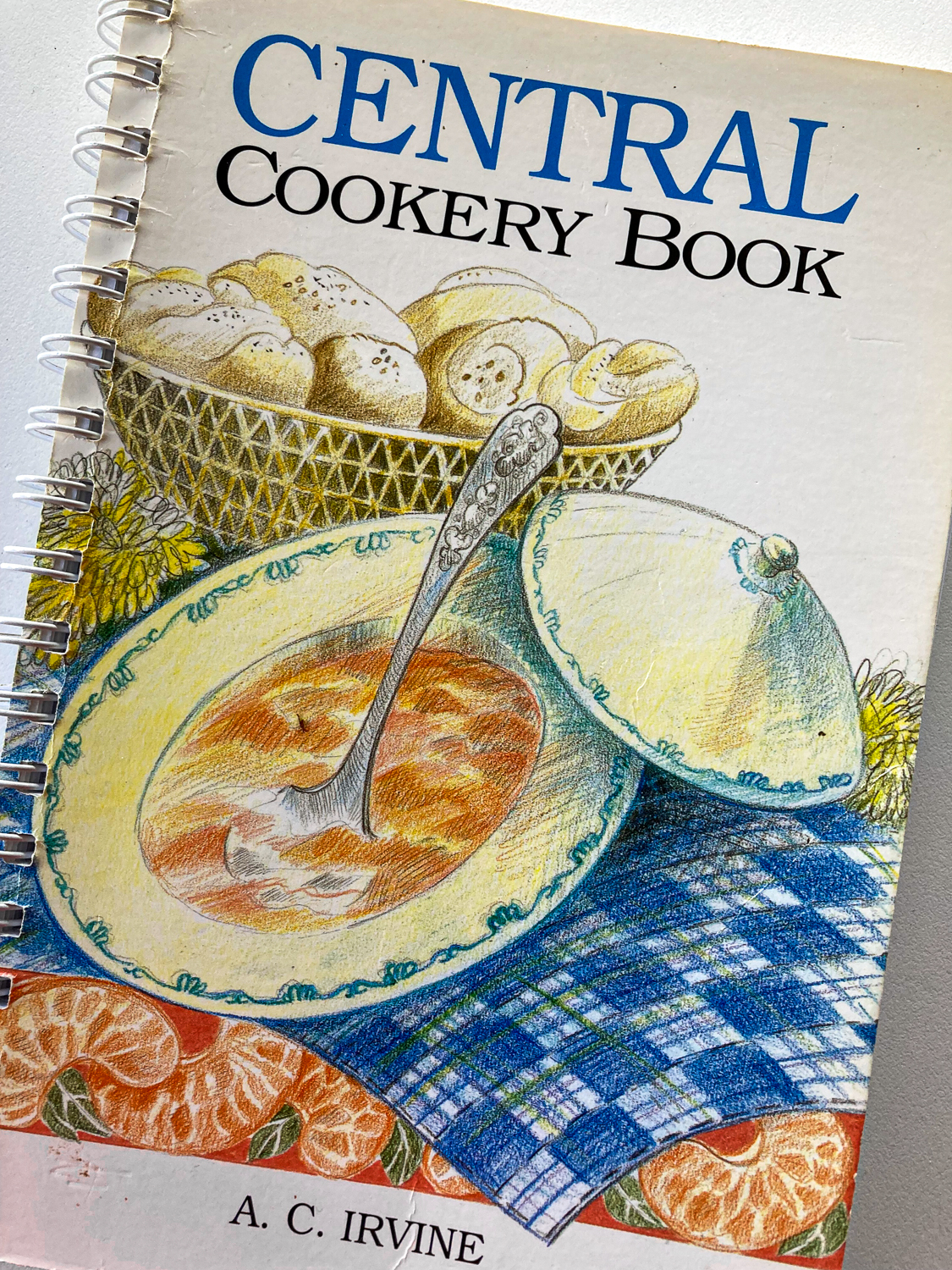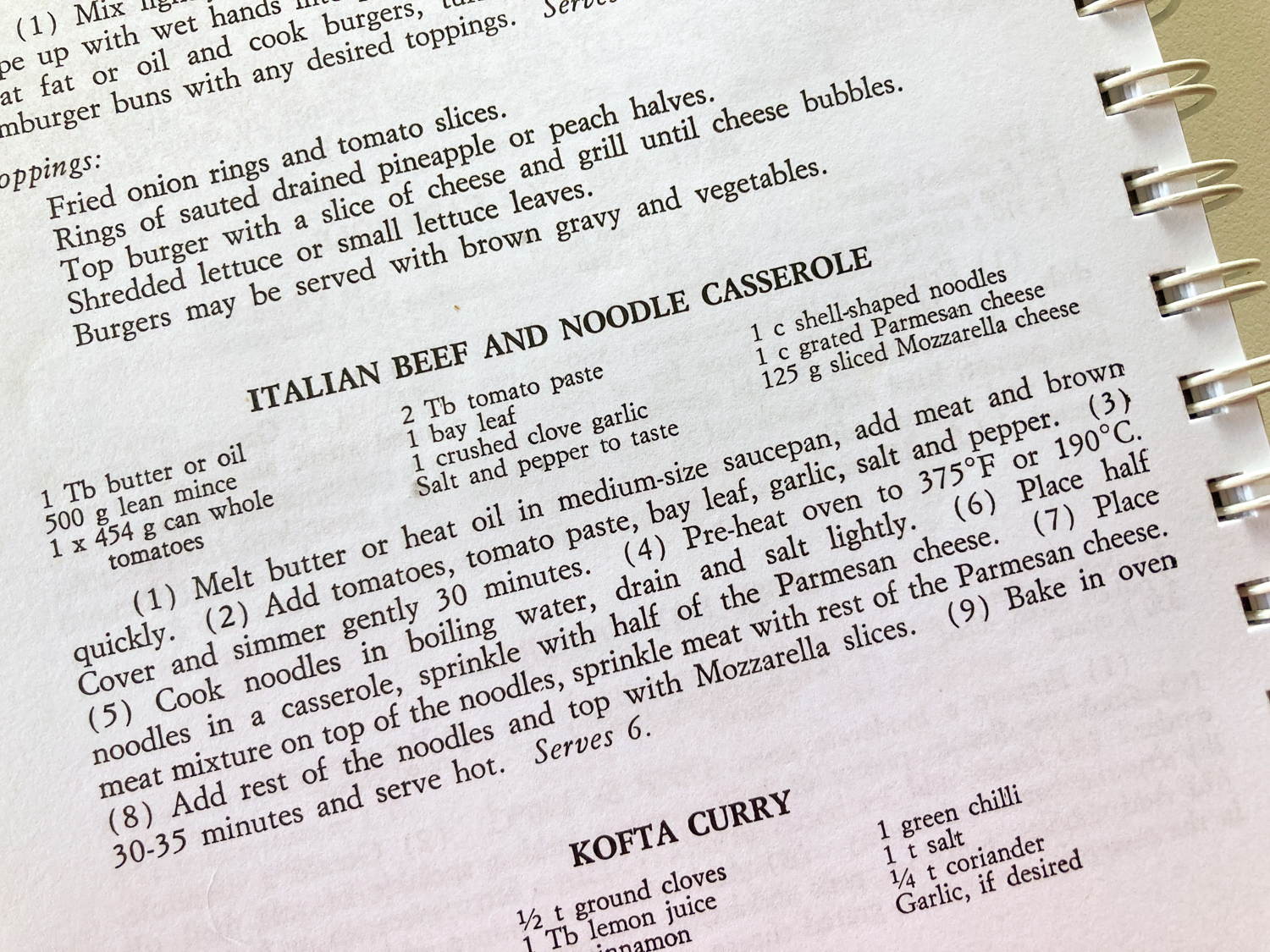Week 16/2023: The central cookery book
Week of 17 April 2023
The Central Cookery Book
I recently discovered an Instagram account called @vintagestasrecipes, which posts photos of old cookbooks and related ephemera. It made me think of Tasmania’s best-known old cookbook, The Central Cookery Book, which was probably found in the homes of most Tasmanians, at least of my generation and older.
My mother used to have a very battered old copy of this book, which was written by Miss Alice Irvine, as a text for domestic science classes in Tasmanian schools. Chances are her copy was her original school textbook but at some point she replaced it with a newer version with a blue cover.
I believe the book was updated in 1971 following the introduction of the metric system but I remember cooking with the old imperial measurements in the original copy my mother had so she must have been slow to upgrade.
Miss Irvine is something of a culinary legend and she was inducted into the Tasmanian Honour Roll of Women in 2009 for service to education and training.
According to the Australian Dictionary of Biography, she was born in 1879 at Mathinna, east of Scamander, and started teaching in 1897, becoming head of the cookery school at Wellington Square School, Launceston, in 1907.
My mother told me Miss Irvine was my grandmother’s cooking teacher at Launceston State High School, which is possible, because my grandmother attended that school in 1918-19, around the time that the new cookery school was being established there.
Miss Irvine authored the Central Cookery Book in 1930, by which time she was in charge of the Domestic Arts School in Hobart, a position she held until she passed away in 1940.
I’m not sure what happened to the book my mother had. The version I have, which I had to buy myself, is the 17th edition, printed in 1992 and cost me $16.45 from a shop that didn’t put its name on its price tags. So I’ll never know where I got it from.

The old versions were never spiral bound. I wish I still had my mother’s copy!
The blurb on the back observes that it’s had “comprehensive changes for our times” but remains “the standard cookery reference book in homes throughout the nation”.
Want to know what a flan is (an open tart), what “tepid” means (blood heat), or what it means to “devil” something (to combine either mustard, curry powder or Worcestershire sauce with ingredients)? This book will tell you.
It will also tell you how to prepare stock, potatoes, and gravy, as well as pastry, scones and rice. Classic dishes like Quiche Lorraine, Macaroni Cheese and Curried Eggs and “more testing and exotic dishes like Bortsch, Sukiyaki and Chinese One-Dish Meal”.
And for things my parents used to like, there’s liver, heart and bacon casserole, pressed tongue and, from the breakfast section, brains and bacon.
I’m sure I used to make recipes from this book when I was younger but in recent years the only times I’ve used it have been for Anzac biscuits and pikelets.
My memory suitably jogged I decided it was time to get the book out and make something I’d not made before.
Italian Beef and Noodle Casserole.
I’m not sure what makes this specifically Italian as opposed to any other type of beef and noodle casserole. Perhaps it’s the Parmesan and Mozzarella cheeses.

It can’t be the pasta. You can’t just add pasta to a dish and call it Italian!
I did wonder about “shell-shaped noodles”. I remember them from my childhood, but the fancy Italian-made pasta I buy now doesn’t come in that shape so I wondered if it had been a made-up shape for the Australian market in the 1970s. And then I started wondering, when did Australians start even eating pasta? Had it been introduced during the European migration period of the 1940s and 50s?
This question sent me into a rabbit hole of food history, where I learned that Australia’s first pasta factory was built in 1859 in Hepburn Springs, Victoria. (Though this date is contested.)
And shell pasta is not a made up thing for Australia. It’s a real shape, called conchglie, which means, surprise surprise, “shells” in Italian. It comes in three sizes: small (conchigliette), medium (conchiglie), and “OMG, that is huge”(conchiglioni). I think that one is most often stuffed.
I didn’t get shells, I got Orecchiette and this is what it looked like.

I think I’ll go back to this book more often now and see what other hidden classics I can unearth.
In the mean time, the week rolled on.
I had more time off for my injuries and actually took my camera out a couple of times. Because part of my recovery involves getting up and going for a walk.

Week 16 summary
What was the best thing about this week?
My website got some kind of upgrade and I got a notification that it had all tested okay so I didn’t bother to check it. Bad idea. The front page looked okay but none of the actual posts would load. I sent a very frustrated email to my website people asking what on earth they had done and how could I fix it and I’m a clueless writer with no website skills who is just trying to write a blog and I don’t want to spend any more money on my site just to maintain a system that’s no longer supported!
It turns out it was just a plug-in that wasn’t working and once they disabled that, everything came back.
I really should learn a bit more about how websites work but it’s all too overwhelming! And it’s not broken for now.
What did I learn this week?
The Vacuum Oil Company was founded in the US in 1866 and commenced business in Melbourne in 1895. It was the first oil company to be established in Australia, providing Laurel Kerosene to households for heating and cooking, as well as Flit fly spray. (It later become the Mobil company, with the same flying horse logo.)
What I’m reading this week
- Me and My Big Mouth by Jan O’Connell
- Van Diemen’s Land by James Boyce
Habit tracker
- Morning ritual (Goal = 7): 5
- Move (preferably before 3 pm) (Goal = 7): 7
- Morning writing (Goal = 7): 7
- Finish work by 5.30 (Goal = 3): 3
- Shut my computer down before 9.15 (Goal = 5): 5